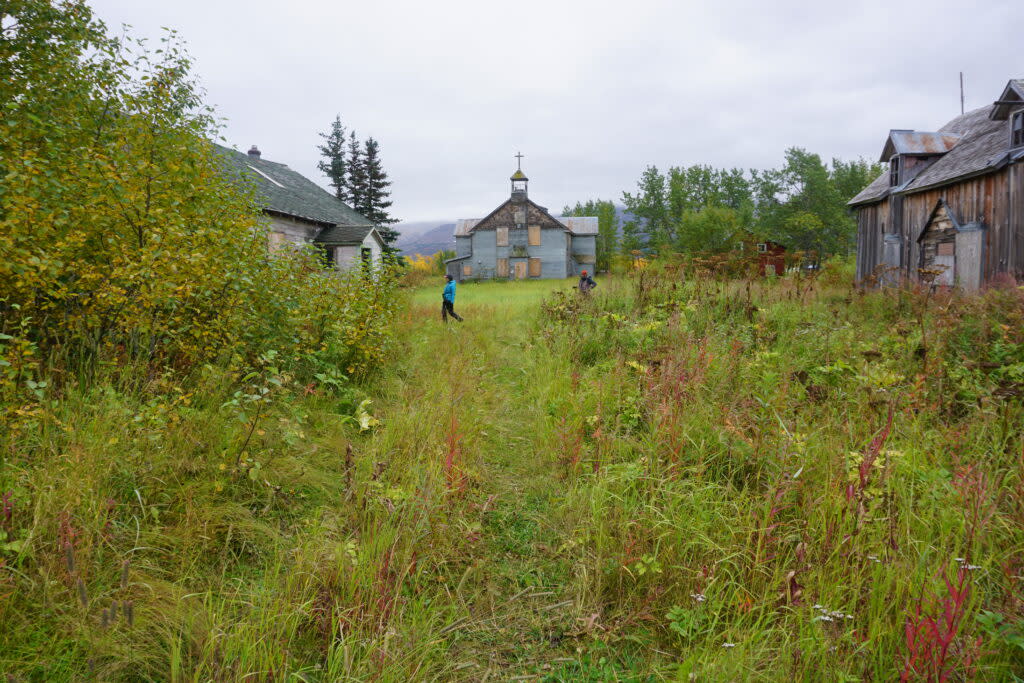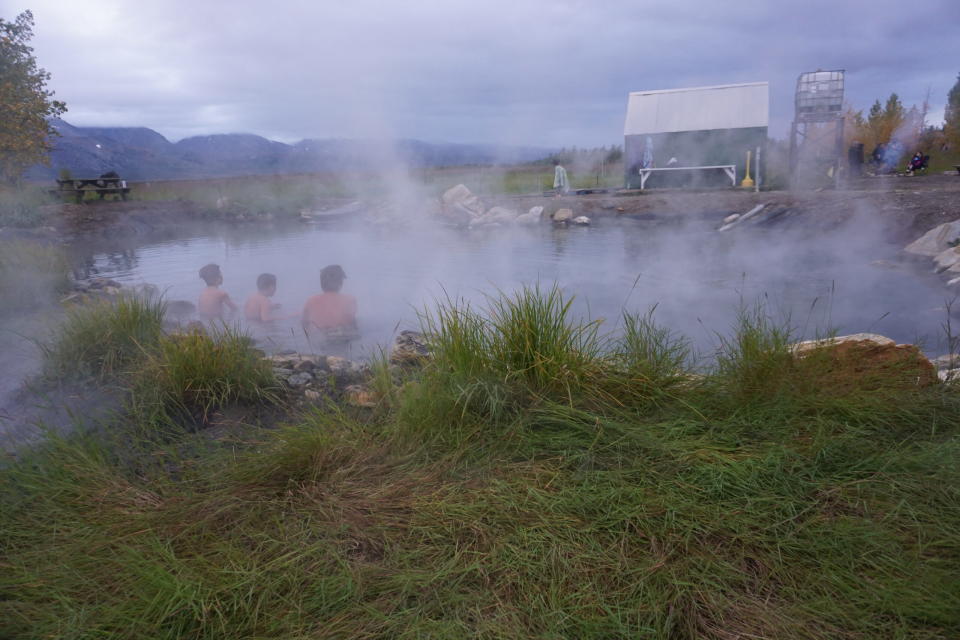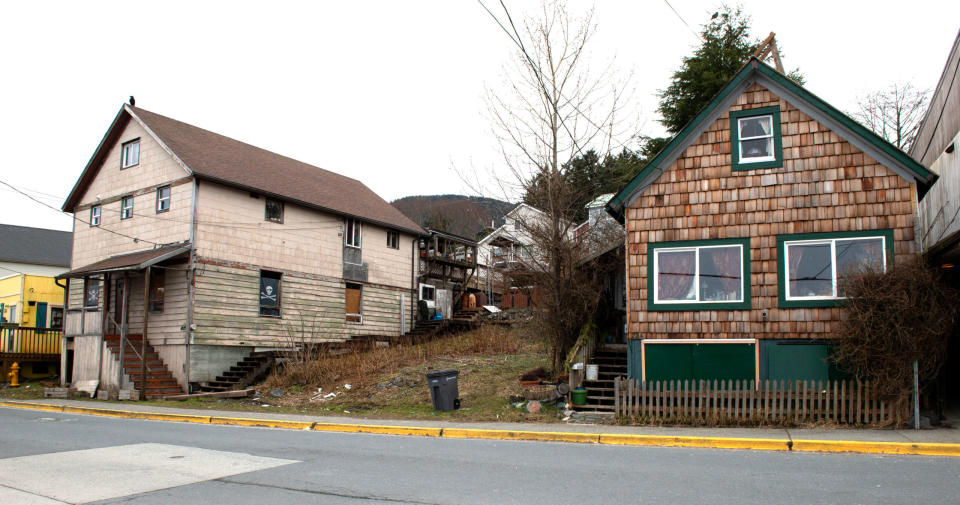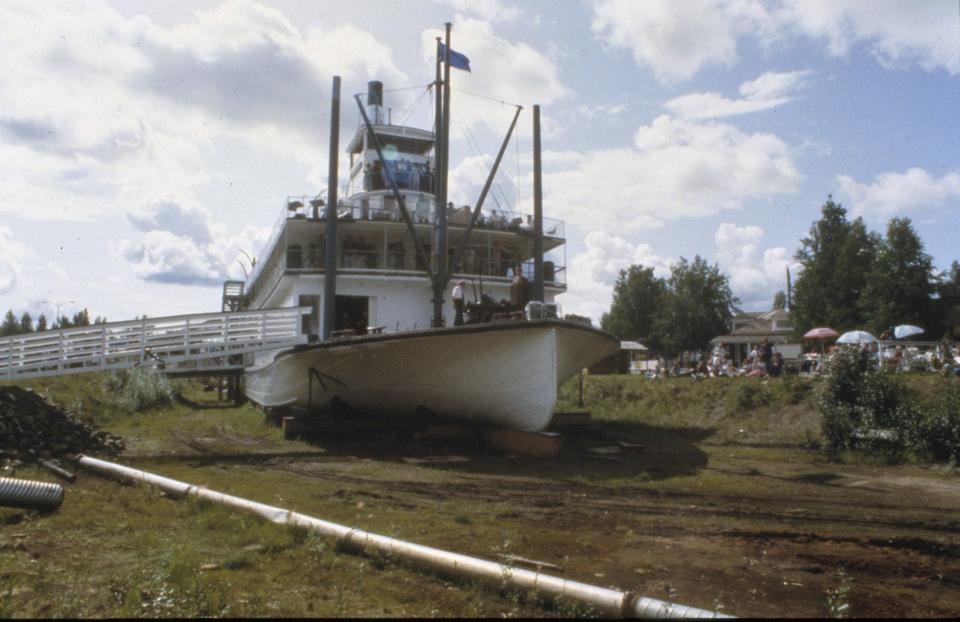Boats, a lighthouse, churches among sites named as Alaska’s most at-risk historic properties

Visitors on Sept. 4, 2021, stroll by the historic chapel and buildings used for classrooms and dormitories that remain standing at Pilgrim Hot Springs. The site was used as an orphanage for Bering Strait-area children who lost their parents to the 1918-19 influenza epidemic. Pilgrim Hot Springs is among the state's 11 most endangered historic properties, according to an annual list released by Preservation Alaska. (Photo by Yereth Rosen/Alaska Beacon)
Eleven sites from Southeast Alaska to the Bering Strait region were named Friday as the state’s most endangered historic properties.
The annual list was released by Preservation Alaska, the nonprofit formally called Alaska Association for Historic Preservation. The organization has been publishing lists of top endangered properties since 1991; usually there are 10 on each year’s list, but this year’s list was expanded.
“This annual list is intended to bring public awareness to Alaska’s threatened historic properties. Heightened awareness often leads to increased support for the conservation of endangered historic properties, which are assets important to tourism, economic development, and the cultural heritage of Alaska,” Preservation Alaska said in its announcement.
Threats to the listed properties include pending development, extreme weather events and the simple ravages of time.

Three boys soak in a pool at Pilgrim Hot Springs on Sept. 4, 2021. The historic area is a popular recreation destination for Nome residents. (Photo by Yereth Rosen/Alaska Beacon)
Topping this year’s list is the Wolf Creek Boatworks near Hollis on Southeast Alaska’s Prince of Wales Island. The facility dates to 1939, when it began producing boats made from local Alaska timber. At present, it is threatened by logging planned by the Alaska Mental Health Trust, which gained ownership of the surrounding land in a 2019 trade with the U.S. Forest Service. The historic boatworks would be demolished if the logging plan is carried out, Preservation Alaska said.
Second on the list is Pilgrim Hot Springs, a popular recreation destination about 60 miles northeast of Nome.
Originally used by the region’s Indigenous people and later used by Gold Rush miners, the hot springs became the site of a Catholic orphanage that housed children who lost their parents to the 1918-19 influenza pandemic.
The site is now owned and operated by Unaatuq LLC, a consortium of seven Bering Strait region organizations. Repairs to time-worn buildings have been underway, and Unaatuq has had to contend with a new threat: flooding caused by beavers that are spreading north and building dams in new places as the climate warms and woody plants proliferate in new areas.

Some of the remaining clan houses in the Sitka Indian Village are seen in this undated photo. There were originally more than 40 houses, and they served as more than dwellings. The clan houses were cited by both historic preservation organizations as being among the most at-risk historic properties in Alaska and the nation. Preservation efforts are focusing on restoring and rebuilding structures, sorting out land ownership and strengthening Tlingit tradition. (Photo by James Poulson/provided by National Trust for Historic Preservation)
Also on the list is the Sitka Indian Village, a community established about 200 years ago that once comprised of more than 40 Tlingit clan houses. Those clan houses were also cited as a top national preservation priority in a list of the 11 most endangered U.S. historic properties that was released earlier in the week by the National Trust for Historic Preservation.
There are now only eight houses standing, and only some of them are still functioning in the traditional way, according to the national organization.
In Tlingit tradition, clan houses are not just dwellings but also cultural gathering sites organized in a matriarchal structure. The Sitka houses have suffered from more than physical deterioration, said Jerrick Hope-Lang, a Kiks.ádi clan member working on restoring the site and its traditions. Church leaders of the past promoted the idea of the nuclear family over the Tlingit matrilineal system, and that influence, along with U.S. inheritance laws and practices created complex ownership with multiple heirs, a situation that needs to be worked out, Hope-Lang said.
The 2024 Preservation Alaska list includes two churches. One, the Ascension Church of Our Lord Chapel at Karluk on Kodiak Island, is threatened by continued coastal erosion, the organization said. The other, the Bishop Rowe Chapel in Arctic Village, has fallen victim to a harsh and rapidly changing Arctic climate.

The SS Nenana, with summer visitors, is seen in Fairbanks in 2008. The historic steamship is housed at Pioneer Park in Fairbanks. (Photo provided by National Park Service)
The list also includes boats. One of those properties is a collection of 14 wooden boats in Naknek that date back to the 19th century; the crafts were used in the early days of the Bristol Bay salmon fishery, before motorized boats were allowed. The Bristol Bay Historical Society is trying to develop an old mercantile building into a museum to house the boats.
Another boat on the list is the SS Nenana, a steamship currently housed at Pioneer Park in Fairbanks. The ship fell into such disrepair that it was deemed unsafe and closed to visitors, but restoration work led by the nonprofit Friends of SS Nenana has made enough progress that the ship will be reopened to visitors this summer, Preservation Alaska said.
Elsewhere in the Fairbanks region is another site on Preservation Alaska’s list: the Hi-Yu Stamp Mill, which supported a gold mining operation in the early 20th century and is, despite disrepair and vandalism, “still one of the best and only surviving examples of early underground mining and milling in interior Alaska,” according to Preservation Alaska. The Hi-Yu Stamp Mill is now threatened by planned expansions of the Kinross Fort Knox mining projects, according to the organization.
Other sites on the list are the Chitina Emporium, a now-uninhabitable building that was once a community anchor with a hotel, bar, store and power source; the Eldred Rock Lighthouse near Haines, which was built in 1905 and is the oldest original lighthouse in Alaska; and the Pioneer Hall in Ketchikan, a community landmark that needs significant upgrades to meet safety codes, the organization said.
GET THE MORNING HEADLINES DELIVERED TO YOUR INBOX
The post Boats, a lighthouse, churches among sites named as Alaska’s most at-risk historic properties appeared first on Alaska Beacon.

